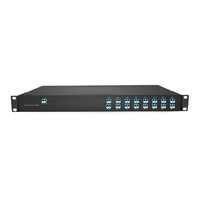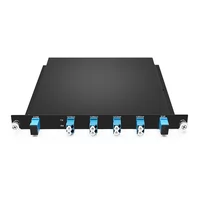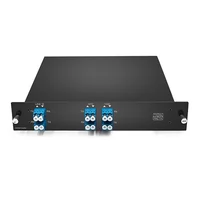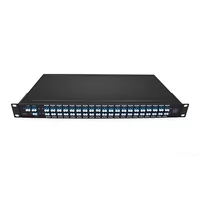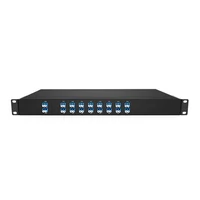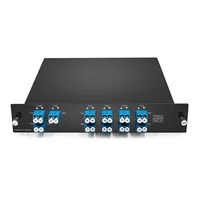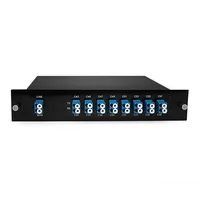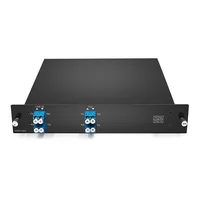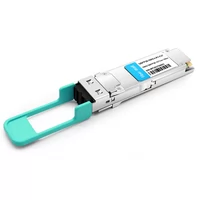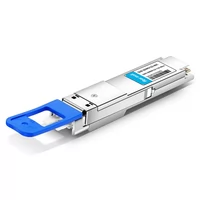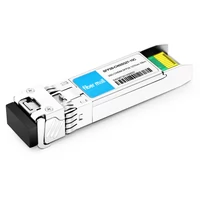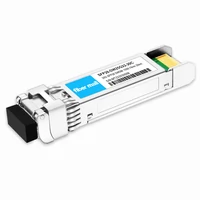High data transmission rates are increasingly needed in the changing world of communication. Among the many ways of achieving this, Coarse Wavelength Division Multiplexing (CWDM) and Dense Wavelength Division Multiplexing (DWDM) have proven to be the most effective. These two technologies utilize light wavelengths to transmit multiple data streams through a single optical fiber. However, their applicability differs significantly, and each has unique merits. This write-up seeks to comprehensively compare CWDM against DWDM by looking at what they are made up of, their advantages and disadvantages, or even where they can be best used so that one can choose wisely which technology should be adopted based on their network requirements.
Table of Contents
ToggleWhat are CWDM and DWDM in Fiber Optics?

Understanding CWDM Technology
Coarse Wavelength Division Multiplexing (CWDM) is a technology that simultaneously transmits many data streams over one fiber optic cable, with each signal having its unique wavelength. The wavelengths are usually spaced rather far apart, so this method is best suited for short to medium-haul networks. There can be as many as 18 channels in this system, and they should be separated by no less than 20 nanometers. This type of system employs passive components, so it is cheaper than other methods. It can also increase capacity without requiring major infrastructure changes, which makes it perfect for metropolitan area networks or access network expansion on tight budgets. CWDM works well when simplicity will suffice because it’s cheap and doesn’t require high-capacity solutions in places where low-cost ones work fine, too.
Introduction to DWDM Systems
More advanced than CWDM, Dense Wavelength Division Multiplexing (DWDM) is designed to optimize the data-carrying capacity of optical fibers. For instance, wavelengths used by DWDM are closely spaced, usually 0.8 nanometers (100 GHz) or 0.4 nanometers (50 GHz), apart from each other. This dense spacing enables DWDM systems to support many more channels, sometimes upwards of 80 per fiber pair. It has long-haul and high-capacity metro networks covered in range and capacity because it can go far without losing signal strength or quality. Active temperature controls and high-quality lasers are among the precise and sometimes costly requirements for components. Scalability is key in telecommunications environments where high capacity and performance levels matter most – this is why these places commonly use DWDM technology.
How CWDM and DWDM Work in Optical Networks
CWDM and DWDM help improve the capacity of optical networks by allowing more than one data signal to be carried over a single optical fiber through wavelength management. Still, they are implemented differently and have diverse applications.
CWDM uses wide-spaced wavelengths (20 nm) along with passive components, making it cost-effective for enhancing capacity in metropolitan area networks (MANs) of short-to-medium range. This technology commonly supports up to 18 channels and is well-suited for environments where lower capacity and more straightforward configurations suffice.
Conversely, DWDM employs much closer wavelength spacing (0.4 nm to 0.8 nm), which requires more accurate active components, which are usually expensive. This allows DWDM systems to accommodate many more channels, often exceeding 80, hence making them appropriate for long hauls or high-capacity metro networks where performance, scalability, and capacity matter most.
In these two methods, various channels are multiplexed over an optical fiber, although their wavelength spacing, hardware requirements, and application scope, among other factors, may influence their deployment in different network scenarios.
How Do CWDM and DWDM Differ in Terms of Wavelength?

Wavelengths Used in CWDM
CWDM, or Coarse Wavelength Division Multiplexing, uses a wavelength range of 1270 nm to 1610 nm, separating each channel by 20 nm. Because of the larger spacing, the design is simplified and cheaper, but fewer channels can be accommodated. The ITU-T G.694.2 recommendation identified the standard CWDM grid, which allocated 18 different channels in this band of wavelengths. These more considerable intervals between spacings allow uncooled lasers and passive devices that make it cost-effective for metropolitan area networks (MAN) and access network applications over short distances.
DWDM Wavelength Specifications
DWDM, or Dense Wavelength Division Multiplexing, is a technology that uses closely spaced wavelengths between 1525 nm and 1565 nm (the C-band) but may also extend into the L-band (1570 nm to 1610 nm). Each channel is packed even closer with a typical spacing of 0.8, 0.4, or even 0.2 nm. The space is squeezed in DWDM to put more channels on one fiber. With this compact spacing, DWDM systems can support many more channels than other technologies – often up to or even exceeding 96 channels per fiber – thus filling up the capacity of an optical fiber. The DWDM Grid is defined by the ITU-T G694.1 recommendation, which specifies the exact frequency spacing and wavelength allocations. To tune lasers precisely and keep them at a required temperature, DWDM systems usually have cooled lasers and use advanced modulation techniques, which make such systems costly but highly performant and scalable for long-haul, high-capacity networks.
Channel Spacing: CWDM vs DWDM
To tell the difference between CWDM and DWDM channel spacing, one must look at each technology’s technical characteristics and where it is used. This is done using uncooled passive components, which cost less for short-distance applications like metro or access networks because they have wider spacing at 20 nm that can support fewer channels, usually 18 within the 1270 nm to 1610 nm range. In contrast, DWDM employs narrow channel spacings, often near 0.8nm apart, so that many more channels can fit in – up to 96 or even higher numbers. The dense packing of wavelengths requires cooled lasers and precision components, thereby making the system more expensive. Still, the increased capacity and scalability of DWDM can cater to long-haul high-capacity networks, thus improving performance significantly while allowing transmission over more considerable distances.
Which is Better: CWDM or DWDM?

Suitability for Long-Distance Data Transmission
When it comes to long-distance information transmission, CWDM and DWDM need a good evaluation, but as a matter of fact, the second one is the best. As opposed to CWDM, which supports 18 channels within its operational range, DWDM can go beyond hundreds of kilometers without any signal regeneration. The truth is that these modulation techniques used by cooled lasers in DWDM and stable signals are very important, especially when dealing with wider distances that other signals fail to reach. Moreover, the narrow channel spacing system used in this technology increases the number of wavelengths, thus making bandwidths very large, ultimately saving time for more data to be transmitted simultaneously. On the other hand, due to dispersion and attenuation losses, susceptibility is greater in shorter distances, hence limiting it over such areas because components are uncooled. Therefore, if you want high-capacity networking applications for long hauls where scalability matters most, then choose DWDM because performance counts, too!
Scalability of CWDM and DWDM
When thinking of scalability, DWDM has more benefits than CWDM. More channels can be supported by DWDM systems within the same fiber link – up to 96 or even more. These large numbers are achieved because of narrow channel spacing, which is usually 0.8 nm as compared to its counterpart, where we use wider channel spacing of about 20nm typically while dealing with the latter type, so DWDM can support many channels on one fiber cable according to DWDM vs CWDM. Density packing wavelengths increase data rate and overall capacity, i.e., higher speeds can be transmitted over long distances using fewer cables with this technology, thus making it very flexible for growing network needs.
On the other hand, though cheapness and simplicity make components used in construction attractive options for areas that require low capacity levels over shorter distances, there is still a limitation imposed by the number of available channels, which in most cases do not exceed eighteen, unlike DWDMS. In comparison between these two technologies, when it comes down to scalability, this only means one thing – limited scalability, if any at all, for some applications because there just aren’t enough channels provided by CW-DMX.
In other words, CW-DMX is a cost-effective solution for small networks, while DWMX should be adopted by those who need large-scale designs capable of handling heavy traffic volumes generated in future years through additional data transmission capability enhancements (DWDC).
Cost Considerations: CWDM vs DWDM
When you contrast the costs of CWDM and DWDM, it is important to include both capital (CapEx) and operational expenditure (OpEx). Inexpensive at the beginning is usually a characteristic of CWDM systems. They do this by using less complex laser components that are uncooled. Additionally, they have wider channel spacing, so fine-tuned equipment is not required. This simplification during design leads to lower CapEx, making CWDM an affordable solution for low data rate applications over short distances.
On the other hand, despite being costly in the initial phase, DWDM offers great long-term benefits that outweigh the higher CapEx required. The necessary narrow channels combined with advanced technology increase prices for items such as multiplexers/transponders/amplifiers, among others, used in this system. Nevertheless, scalability can be improved due to efficiencies realized with these systems, where more signals can travel without losing quality over large distances, thus becoming future-proofed.
Regarding operation expenses (OpEx), when viewed through a more significant scale context, especially on intercity deployments, DWDM may prove cheaper over time than any other technology currently available within its class. With the ability to expand capacity without deploying additional fibers, ongoing operational costs are reduced, hence showing how much more efficient DWDM is compared to CWDM, which cannot achieve this level of cost savings at all. Further, better use of existing resources may result from higher data rates associated with DWDM, improving long-term cost efficiency.
Hence, while providing an inexpensive alternative suitable for small-scale, low-end needs, it still doesn’t beat the high scalability coupled with extended-range cost benefits offered by dense wave division multiplexing systems in wide-area networks or metropolitan areas.
How Many Channels Do CWDM and DWDM Support?

CWDM Channels Explained
CWDM enables 18 channels between 1270 nm and 1610 nm. The spacing of these channels is separated by only 20 nm, which is not a lot; this reduces complexity in optical components and limits interference. It should be noted that because the separation between channels is larger than in DWDM systems (which space them out by only 0.8nm), you can’t transmit signals over long distances without some kind of amplification; this means CWDM’s range without boosters typically doesn’t exceed 80 km making it ideal for metro networks or short haul links where distances traveled are less. This trade-off restricts scalability on capacity and reach for CWDM but offers an affordable option where those requirements aren’t necessary.
Number of Channels in DWDM Technologies
In terms of the number of channels, DWDM far exceeds CWDM. Currently, most systems operate within the C-band (1530-1565 nm), providing the most balanced performance and cost-effectiveness. Such systems offer between 40 to 96 channels. However, advanced ones can reach up to 192 channels using the C-band and L-band (1565-1625 nm). In DWDM, adjacent channels can be spaced as close as 0.4 nm apart, enabling data transmission over long distances without interference or signal loss. Because of this high channel density, DWDM has a huge capacity for storing data; thus, it can be used for large-scale networks.
Comparing Channel Capacities of CWDM and DWDM
Based on current industry insights, several main differences exist between the channel capacities of CWDM and DWDM. CWDM is meant for shorter distances and lower capacity applications as it has 18 channels spaced 20 nm apart. Its simplicity and cost-effectiveness make it ideal for metropolitan and enterprise environments where long distance and high data rates are not as important. For these situations, up to 18 channels can be supported by CWDM. On the other hand, DWDM supports many more channels, typically 40-96 in the C-band alone, or even up to 192 if both C-band & L-band are used together. The closer channel spacing of (0.8nm-0.4nm) in DWDM allows large volumes of data to be transmitted over longer distances without interference, making it perfect for high-capacity, long-haul networks. Therefore, DWDM is a more scalable and robust solution for wider communication infrastructures that need more significant bandwidths at further ranges.
What are the Common Applications of CWDM and DWDM?

Utilizing CWDM in Telecom Access Networks
In telecom access networks, CWDM uses its specific properties for different communication needs. Metro and access networks commonly use CWDM technology because it is cheap and easy to implement. It works best for applications that require shorter distances, usually up to 80km, over unamplified optical links, which lowers the overall network costs. With the ability to support 18 channels simultaneously, CWDM allows service providers to increase network capacity without significant infrastructure changes, which makes it a flexible technology for metro networks. Therefore, this makes it very suitable for connecting base stations within mobile networks, enabling business services, and bringing broadband to residential areas. Furthermore, its filters are simpler while cooling requirements are not very strict, making CWDM attractive in places where DWDM could be hard to deploy due to wide coverage constraints.
DWDM in Data Center and Enterprise Networks
Dense Wavelength Division Multiplexing (DWDM) is vital for data centers and enterprise networks because it can support great bandwidth demands over long distances. This implies that DWDM technology sends many data channels through one optical fiber, each on its wavelength. Such an arrangement enables data centers to deal with huge traffic without too many cables.
Data redundancy establishment among various locations and the provision of high-speed network links that can support applications like cloud services streaming or large-scale storage solutions are reasons why DWDM is deployed in data centers. On the other hand, for enterprises, robustness, and scalability are significant considerations when designing communication infrastructures, which should also allow for easy transfer of information between head offices, branch offices, disaster recovery sites, etcetera; hence, this technology becomes essential. Dense wavelength division multiplexing uses small spaces between different channels onto a single fiber optic cable to maximize channelization. In addition to being compatible with several network protocols, DWDM easily integrates with existing hardware, thus making it an essential component of any modern strategy for enterprise networks or data centers.
Deploying CWDM and DWDM in Different Network Scenarios
Deciding whether to use Coarse Wavelength Division Multiplexing (CWDM) or Dense Wavelength Division Multiplexing (DWDM) relies on factors that include distance, bandwidth requirements, and cost considerations. CWDM is used in metropolitan area networks (MANs) and access networks for cost-effectiveness and simplicity. It has few channels and larger wavelength spacing, designed for shorter to medium distances that go up to 80 km, therefore minimizing the need for signal amplification, making it easier to maintain.
On the other hand, DWDM is the most suitable technology for long-haul and high-capacity applications. With narrow wavelength spacing that can support hundreds of channels, it allows data transmission over very long distances, sometimes exceeding several thousand kilometers, without considerable degradation of signals. Backbone networks extensively utilize DWDM systems together with large-scale enterprise networks plus data center interconnects where there is a need for transmission with high bandwidths over long ranges. DWDM, being more expensive than CWDM, offers superior scalability besides better future-proofing, thus becoming the ideal option when dealing with the robustness and expansiveness required by different network solutions.
Reference Sources
Frequently Asked Questions (FAQs)
Q: What is the difference between CWDM and DWDM in WDM technologies?
A: The most important distinction between CWDM (Coarse Wavelength Division Multiplexing) and DWDM (Dense Wavelength Division Multiplexing) is that with CWDM, there are usually fewer channels that are more widely spaced than in the case of DWDM. Besides, the latter can support many more channels closer together, thus making it possible for DWDM to transmit more significant amounts of data over longer distances, which suits larger fiber network applications.
Q: How many channels can CWDM and DWDM support?
A: Typically, up to 18 channels may be supported by CWDM systems, whereas these numbers reach 96 or even 160 wavelengths in some advanced versions of DWDM systems.
Q: What are the typical applications of CWDM and DWDM?
A: Frequently used for shorter distances and medium-capacity fiber networks, CWDM is known as a flexible technology. On the other hand, when it comes to long-distance applications or high-capacity networks needing large amounts of data transmission over extended periods, nothing beats DWDM technology.
Q: How do CWDM and DWDM handle different wavelength requirements?
A: In most cases, CWDMs have their wavelengths spaced apart quite far, about 20 nm intervals, while those for DWDMS are much closer together at either 0.8 nm or 0.4 nm spacing. As a result, more channels can be fitted onto one fiber optic cable using dense wavelength division multiplexing to achieve maximum bandwidth utilization.
Q: Are there differences in the type of optical fiber used in CWDM and DWDM?
A: Although similar types of optical fibers can be employed for both these systems, sometimes higher-quality ones made with greater precision may be required by certain types or versions only, such as dense wavelength division multiplexers, which need them due to their denser light wavelengths used during operation.
Q: What is the difference between CWDM and DWDM in terms of cost?
A: CWDM generally costs less than DWDM because it requires less precise equipment and fewer components. In addition, CWDM is more deployable and, hence, appropriate for smaller networks and shorter distances than any other system. However, DWDM requires highly sophisticated instruments and a greater number of components, resulting in higher costs but providing larger capacities over longer ranges, which makes it ideal for large-scale deployments.
Q: Can you mix CWDM with DWDM on the same fiber network?
A: There are certain configurations where one can use both CWDM and DWDM in the same network. Adding more channels to an existing network that uses only CWDM channels will increase overall data capacity and network efficiency since this is what DWDM systems do best.
Q: What are DWDM transceivers used for? How does it make a difference in making a good working environment for these types of networks?
A: These specialized devices convert electrical signals into optical signals at specific wavelengths of light to transmit them over long-distance fiber optic cables, which use dense wavelength division multiplexing technology (DWDM). They ensure high data integrity and allow higher throughput rates over longer distances along DWDM channels.
Q: Why is CWMD considered flexible technology when deploying networks?
A: It is usually said to be flexible because it’s easy and cheap to deploy compared to other technologies like dark fiber or dense wave division multiplexing. Therefore, adding additional channels without changing much infrastructure can scale up CWMD systems according to growing needs within any expanding webwork setup.
Q: How do these two different types tackle various network problems?
A: Each type employs distinct methods based on wavelength division multiplexing concepts to solve different networking challenges. CWDM is cost-effective for short hauls and specifically designed for applications with cost constraints and limited distances between points needing connectivity at one time. At the same time, dense wave division multiplexing considers long-range transmissions over a single fiber requiring many closely spaced precise wavelengths.
Related Products:
-
 Passive CWDM Double Fiber Mux & Demux Module 16 CH (1310-1610nm) 1U Rack
$570.00
Passive CWDM Double Fiber Mux & Demux Module 16 CH (1310-1610nm) 1U Rack
$570.00
-
 CWDM MUX 4CH 8 Wavelengths (TX: 1470/1490/1510/1530nm RX: 1550/1570/1590/1610nm) with Express Port LC/UPC Single Fiber LGX BOX
$150.00
CWDM MUX 4CH 8 Wavelengths (TX: 1470/1490/1510/1530nm RX: 1550/1570/1590/1610nm) with Express Port LC/UPC Single Fiber LGX BOX
$150.00
-
 Passive CWDM Double Fiber 4 Channels OADM LGX BOX
$250.00
Passive CWDM Double Fiber 4 Channels OADM LGX BOX
$250.00
-
 Low IL 3.5dB DWDM MUX DEMUX 40CH (C21-C60) LC/UPC Dual Fiber 1U Rack
$1200.00
Low IL 3.5dB DWDM MUX DEMUX 40CH (C21-C60) LC/UPC Dual Fiber 1U Rack
$1200.00
-
 DWDM MUX DEMUX 16CH (C21-C36) with Monitor Port LC/UPC Dual Fiber 1U Rack
$800.00
DWDM MUX DEMUX 16CH (C21-C36) with Monitor Port LC/UPC Dual Fiber 1U Rack
$800.00
-
 DWDM MUX DEMUX 8CH (C21-C28) with Express Port LC/UPC Dual Fiber LGX BOX
$500.00
DWDM MUX DEMUX 8CH (C21-C28) with Express Port LC/UPC Dual Fiber LGX BOX
$500.00
-
 DWDM MUX 8CH 16 Wavlengths (TX: C43/C45/C47/C49/C51/C53/C55/C57 RX: C44/C46/C48/C50/C52/C54/C56/C58) with MON Port LC/UPC Single Fiber LGX BOX
$450.00
DWDM MUX 8CH 16 Wavlengths (TX: C43/C45/C47/C49/C51/C53/C55/C57 RX: C44/C46/C48/C50/C52/C54/C56/C58) with MON Port LC/UPC Single Fiber LGX BOX
$450.00
-
 Passive DWDM Double Fiber OADM Module 2 DWDM Wavelengths (100GHz Spacing) LGX BOX
$200.00
Passive DWDM Double Fiber OADM Module 2 DWDM Wavelengths (100GHz Spacing) LGX BOX
$200.00
-
 QSFP28-100G-LR1-C27 100G CWDM QSFP28 Single Lambda LR 1271nm 10km LC SMF with FEC DDM Optical Transceiver
$600.00
QSFP28-100G-LR1-C27 100G CWDM QSFP28 Single Lambda LR 1271nm 10km LC SMF with FEC DDM Optical Transceiver
$600.00
-
 Q28-2DW2122-80C 100G DWDM QSFP28 PAM4 80km C21 C22 100GHz CS DDM Optical Transceiver
$1600.00
Q28-2DW2122-80C 100G DWDM QSFP28 PAM4 80km C21 C22 100GHz CS DDM Optical Transceiver
$1600.00
-
 SFP28-CW25G27-10C 25G CWDM SFP28 1270nm 10km LC SMF DDM Transceiver Module
$50.00
SFP28-CW25G27-10C 25G CWDM SFP28 1270nm 10km LC SMF DDM Transceiver Module
$50.00
-
 SFP28-DW25G22-20C 25G SFP28 DWDM C22 100GHz 20KM 1559.79nm LC SMF DDM Transceiver Module
$600.00
SFP28-DW25G22-20C 25G SFP28 DWDM C22 100GHz 20KM 1559.79nm LC SMF DDM Transceiver Module
$600.00

